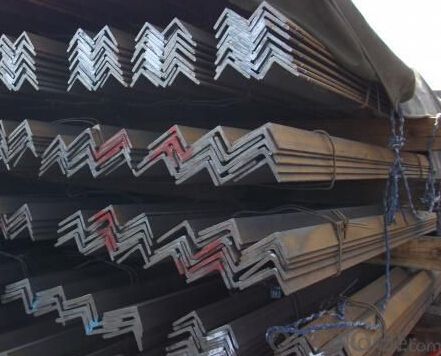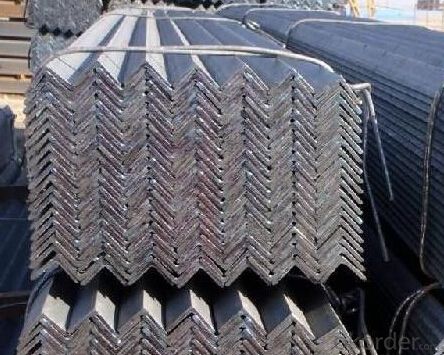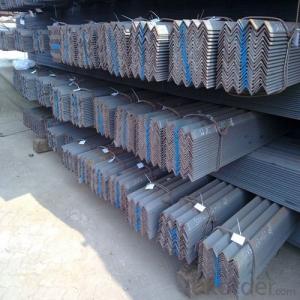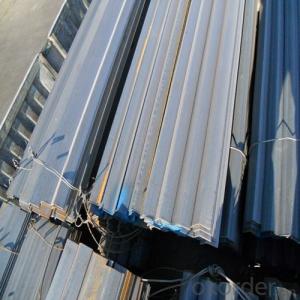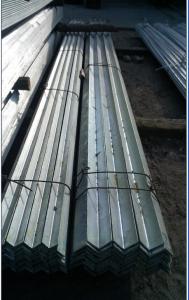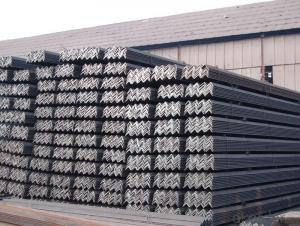GB235/275 A36 Angle Steel
- Loading Port:
- China Main Port
- Payment Terms:
- TT or LC
- Min Order Qty:
- -
- Supply Capability:
- -
OKorder Service Pledge
OKorder Financial Service
You Might Also Like
Product Description:
OKorder is offering GB235/275 A36 Angle Steel at great prices with worldwide shipping. Our supplier is a world-class manufacturer of steel, with our products utilized the world over. OKorder annually supplies products to European, North American and Asian markets. We provide quotations within 24 hours of receiving an inquiry and guarantee competitive prices.
Product Applications:
GB235/275 A36 Angle Steel are ideal for structural applications and are widely used in the construction of buildings and bridges, and the manufacturing, petrochemical, and transportation industries.
Product Advantages:
OKorder's GB235/275 A36 Angle Steel are durable, strong, and resist corrosion.
Main Product Features:
· Premium quality
· Prompt delivery & seaworthy packing (30 days after receiving deposit)
· Corrosion resistance
· Can be recycled and reused
· Mill test certification
· Professional Service
· Competitive pricing
Specifications of GB235/275 A36 Angle Steel
1. Standards: GB,ASTM,BS,AISI,DIN,JIS
2. Invoicing on theoretical weight or actual weight as customer request
3. Material:Material: GB Q235B, Q345B or Equivalent; ASTM A36; EN 10025, S235JR, S355JR; JIS G3192, SS400; SS540.
4. Sizes:
Sizes: 25mm-250mm | ||
a*t | ||
25*2.5-4.0 | 70*6.0-9.0 | 130*9.0-15 |
30*2.5-6.6 | 75*6.0-9.0 | 140*10-14 |
36*3.0-5.0 | 80*5.0-10 | 150*10-20 |
38*2.3-6.0 | 90*7.0-10 | 160*10-16 |
40*3.0-5.0 | 100*6.0-12 | 175*12-15 |
45*4.0-6.0 | 110*8.0-10 | 180*12-18 |
50*4.0-6.0 | 120*6.0-15 | 200*14-25 |
60*4.0-8.0 | 125*8.0-14 | 250*25 |
5. Material details:
Alloy No | Grade | Element (%) | |||||
C | Mn | S | P | Si | |||
|
|
|
|
|
|
| |
Q235 | B | 0.12—0.20 | 0.3—0.7 | ≤0.045 | ≤0.045 | ≤0.3 | |
|
|
|
|
|
|
| |
Alloy No | Grade | Yielding strength point( Mpa) | |||||
Thickness (mm) | |||||||
≤16 | >16--40 | >40--60 | >60--100 | ||||
≥ | |||||||
|
|
|
|
|
| ||
Q235 | B | 235 | 225 | 215 | 205 | ||
Alloy No | Grade | Tensile strength (Mpa) | Elongation after fracture (%) | ||||
Thickness (mm) | |||||||
| ≤16 | >16--40 | >40--60 | >60--100 | |||
≥ | |||||||
|
|
|
|
|
|
| |
Q235 | B | 375--500 | 26 | 25 | 24 | 23 | |
Usage & Applications of GB Q235 Angle Steel
Trusses;
Transmission towers;
Telecommunication towers;
Bracing for general structures;
Stiffeners in structural use.
Packaging & Delivery of GB Q235 Angle Steel
1. Transportation: the goods are delivered by truck from mill to loading port, the maximum quantity can be loaded is around 40MTs by each truck. If the order quantity cannot reach the full truck loaded, the transportation cost per ton will be little higher than full load.
2. With bundles and load in 20 feet/40 feet container, or by bulk cargo, also we could do as customer's request.
3. Marks:
Color mark: There will be color marking on both end of the bundle for the cargo delivered by bulk vessel. That makes it easily to distinguish at the destination port.
Tag mark: There will be tag mark tied up on the bundles. The information usually including supplier logo and name, product name, made in China, shipping marks and other information request by the customer.
If loading by container the marking is not needed, but we will prepare it as customer request.
FAQ:
Q1: Why buy Materials & Equipment from OKorder.com?
A1: All products offered byOKorder.com are carefully selected from China's most reliable manufacturing enterprises. Through its ISO certifications, OKorder.com adheres to the highest standards and a commitment to supply chain safety and customer satisfaction.
Q2: How do we guarantee the quality of our products?
A2: We have established an advanced quality management system which conducts strict quality tests at every step, from raw materials to the final product. At the same time, we provide extensive follow-up service assurances as required.
Q3: How soon can we receive the product after purchase?
A3: Within three days of placing an order, we will begin production. The specific shipping date is dependent upon international and government factors, but is typically 7 to 10 workdays.
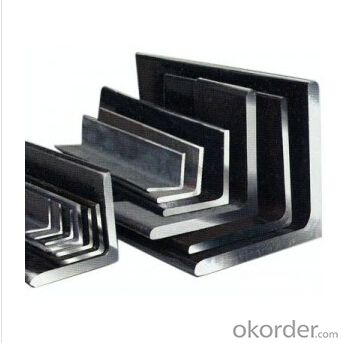
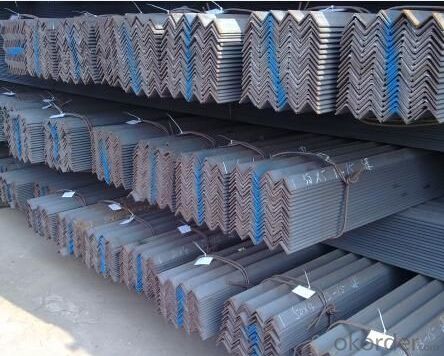
- Q: What is the standard tolerance for steel angles?
- The standard tolerance for steel angles can vary depending on the specific requirements and industry standards. However, in general, the standard tolerance for steel angles is typically specified in terms of the permissible variation in dimensions such as length, width, and thickness. These tolerances ensure that the angles meet the necessary specifications and can be used effectively in various applications. It is important to consult the relevant industry standards or specifications, such as those provided by organizations like the American Society for Testing and Materials (ASTM) or the American Institute of Steel Construction (AISC), to determine the specific tolerance requirements for steel angles in a particular context.
- Q: How do you prevent steel angles from sagging?
- Steel angles can be prevented from sagging by providing adequate support and reinforcement. This can be achieved by using additional structural steel elements such as beams or columns to provide continuous support along the length of the angle. Additionally, appropriate fastening techniques, such as welding or bolting, should be used to ensure a secure connection between the angle and the supporting structure. Regular inspection and maintenance are also essential to detect any signs of sagging and take necessary corrective measures in a timely manner.
- Q: Can steel angles be used in mining or quarrying machinery?
- Yes, steel angles can be used in mining or quarrying machinery. Steel angles provide structural support and reinforcement to various components of machinery used in these industries. They are commonly used in the construction of frames, supports, and brackets for equipment such as crushers, conveyors, and screens. The high strength and durability of steel angles make them suitable for withstanding the heavy loads, vibrations, and harsh operating conditions typically encountered in mining or quarrying operations. Additionally, steel angles can be easily fabricated and welded to meet specific design requirements, making them a versatile choice for machinery applications in these industries.
- Q: How do you calculate the maximum allowable deflection for a steel angle beam?
- To determine the maximum allowable deflection for a steel angle beam, various factors need to be taken into consideration. Typically, the design code or standard being followed dictates the maximum allowable deflection. Here is a general procedure for calculating this deflection: 1. Obtain the properties of the steel angle beam: Acquire information such as the steel angle beam's cross-sectional dimensions, moment of inertia, and modulus of elasticity. These properties can be obtained from the manufacturer's literature or calculated. 2. Establish the applicable design code or standard: Different design codes or standards may have different criteria for allowable deflections. Examples include the AISC Manual, Eurocode, or British Standards. Identify the relevant code for your project. 3. Determine the beam's support conditions: Establish whether the steel angle beam is simply supported or fixed at its ends. The support conditions will impact the calculation of the maximum allowable deflection. 4. Compute the maximum allowable deflection: Utilize the appropriate formula or equation specified in the design code or standard to calculate the maximum allowable deflection. Typically, this formula relies on the span length, beam properties, and support conditions. 5. Consider additional factors or limitations: Some design codes or standards may introduce factors or limitations based on the specific application or load conditions. Take into account any additional factors or limitations specified in the code and integrate them into the calculation. 6. Compare the calculated deflection with the maximum allowable deflection: Once the maximum allowable deflection has been calculated using the relevant formula and any additional factors have been considered, compare it with the calculated deflection of the steel angle beam under the intended load conditions. If the calculated deflection falls within the maximum allowable deflection, the design is deemed acceptable. Otherwise, adjustments to the beam properties or design may be necessary. It is important to note that the aforementioned steps serve as a general guideline for calculating the maximum allowable deflection for a steel angle beam. The specific calculation method may vary depending on the design code or standard being followed, so it is crucial to consult the applicable code or seek professional guidance for accurate and reliable results.
- Q: What are the different types of steel angles used in shipbuilding?
- Various structural purposes in shipbuilding commonly utilize several types of steel angles. These angles are typically crafted from high-strength steel and are intended to confer strength and stability to the ship's structure. Presented below are different steel angle varieties utilized in shipbuilding: 1. Bulb Angles: Specifically designed for ship hull construction, these angles possess a bulbous shape on one side. This unique shape aids in load distribution while adding further strength and stability to the hull structure. 2. L-Shaped Angles: Also known as unequal angles, L-shaped angles find extensive usage in shipbuilding for framing and bracing requirements. With one leg longer than the other, these angles accommodate various applications necessitating varying lengths. 3. Equal Angles: Commonly referred to as L-sections, equal angles consist of two legs of identical length. Shipbuilding extensively employs them for framing and supporting structures, as they confer uniform strength. Their versatility extends to applications such as bulkhead framing and deck support. 4. Flat Bars: While technically not angles, flat bars are frequently employed in shipbuilding for comparable purposes. These bars possess a rectangular cross-section and are primarily used for reinforcement, framing, and connecting different structural components. 5. T-Sections: T-sections, or T-angles, feature a T-shaped cross-section and serve in shipbuilding for structural framing, reinforcement, and component connection. The vertical leg of the T-section imparts additional strength and stability to the structure. 6. Z-Sections: Z-sections, or Z-angles, possess a Z-shaped cross-section and fulfill various shipbuilding purposes such as framing, bracing, and structural support. These angles offer excellent load-bearing capacity and are frequently utilized when maximum strength is required. Ultimately, the selection of steel angles in shipbuilding hinges upon the specific requirements of the structure, encompassing load-bearing capacity, structural design, and intended purpose. The aforementioned steel angle types provide a vast array of options to cater to the diverse demands of ship construction.
- Q: Can steel angles be used in stair construction?
- Yes, steel angles can be used in stair construction. Steel angles are commonly used as structural elements in staircases to provide support and stability. They can be used as stringers, which are the main load-bearing components of a staircase, or as brackets and supports for treads and handrails. Steel angles are known for their strength and durability, making them suitable for use in stair construction to ensure the safety and longevity of the staircase.
- Q: How can steel angles be cut to size?
- Steel angles can be cut to size using various methods such as sawing, shearing, or plasma cutting.
- Q: Are steel angles suitable for outdoor staircases?
- Yes, steel angles are suitable for outdoor staircases. Steel angles have high strength and durability, making them ideal for withstanding outdoor elements such as weather conditions and heavy foot traffic. Additionally, steel angles can be coated or painted to enhance their resistance to corrosion, further increasing their suitability for outdoor staircases.
- Q: Can steel angles be used in the construction of storage tanks?
- Yes, steel angles can be used in the construction of storage tanks. Steel angles are commonly used in the construction industry due to their strength, durability, and versatility. In the case of storage tanks, steel angles can be used as structural components to provide support and stability to the tank's framework. They are often used to create the framework for the tank's walls, roof, and base, ensuring the tank's overall strength and stability. Additionally, steel angles can also be used to reinforce corners and joints, improving the tank's structural integrity. Overall, steel angles are a reliable and cost-effective option for incorporating into the construction of storage tanks.
- Q: What are the different types of steel angles used in automotive engineering?
- There are several types of steel angles used in automotive engineering, including equal angles, unequal angles, and L-shaped angles. These angles are commonly used for structural support, reinforcement, and to provide strength and stability to various components of the vehicle.
Send your message to us
GB235/275 A36 Angle Steel
- Loading Port:
- China Main Port
- Payment Terms:
- TT or LC
- Min Order Qty:
- -
- Supply Capability:
- -
OKorder Service Pledge
OKorder Financial Service
Similar products
Hot products
Hot Searches
Related keywords






